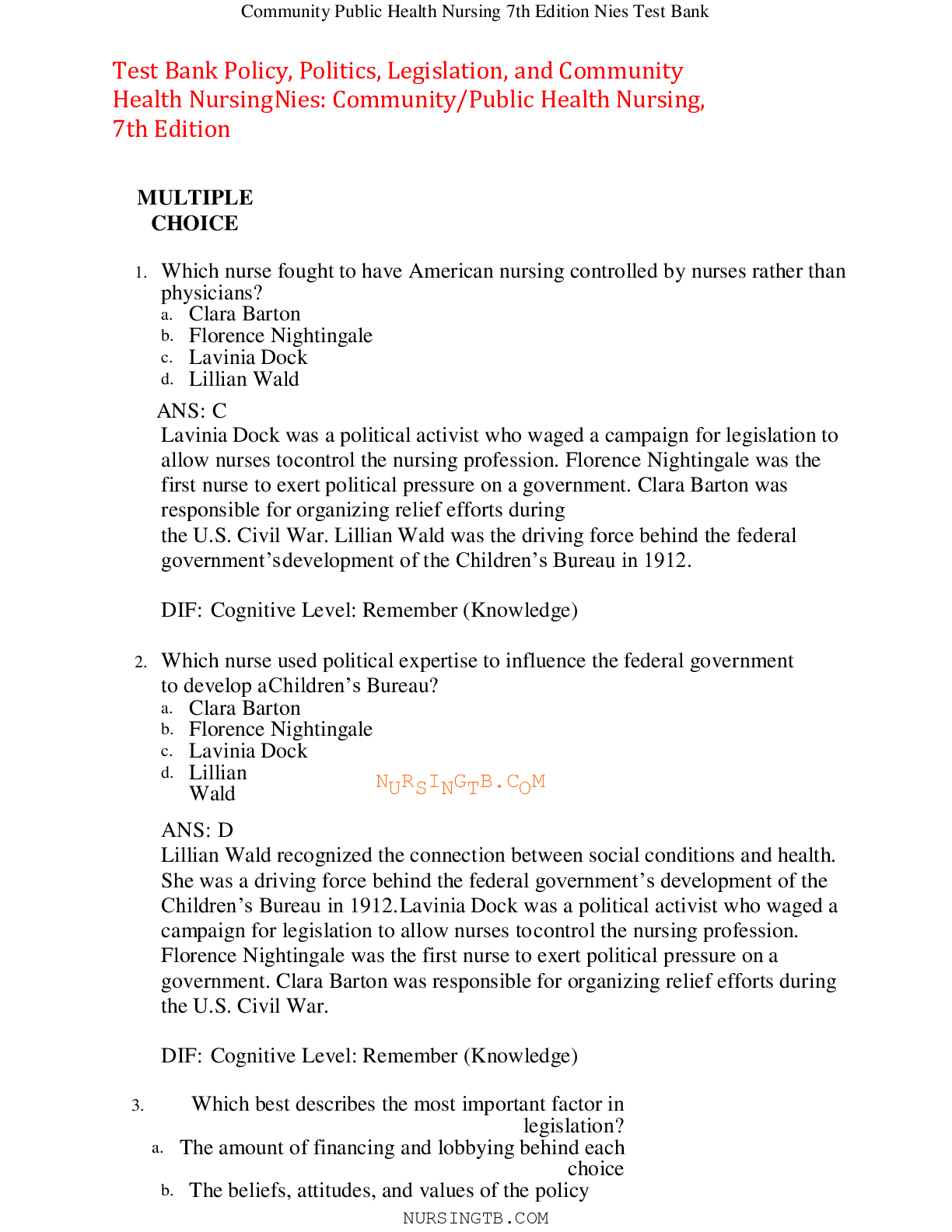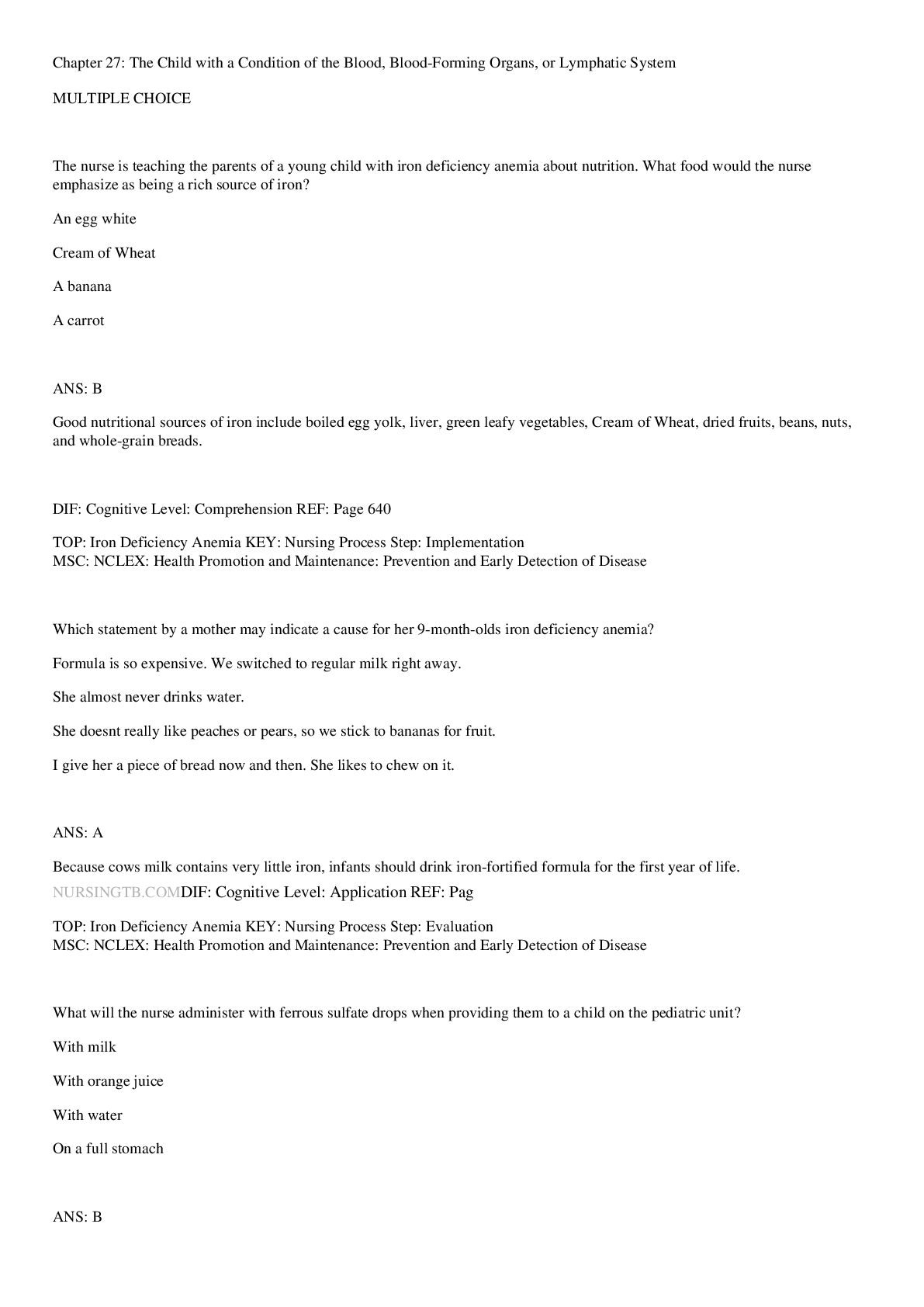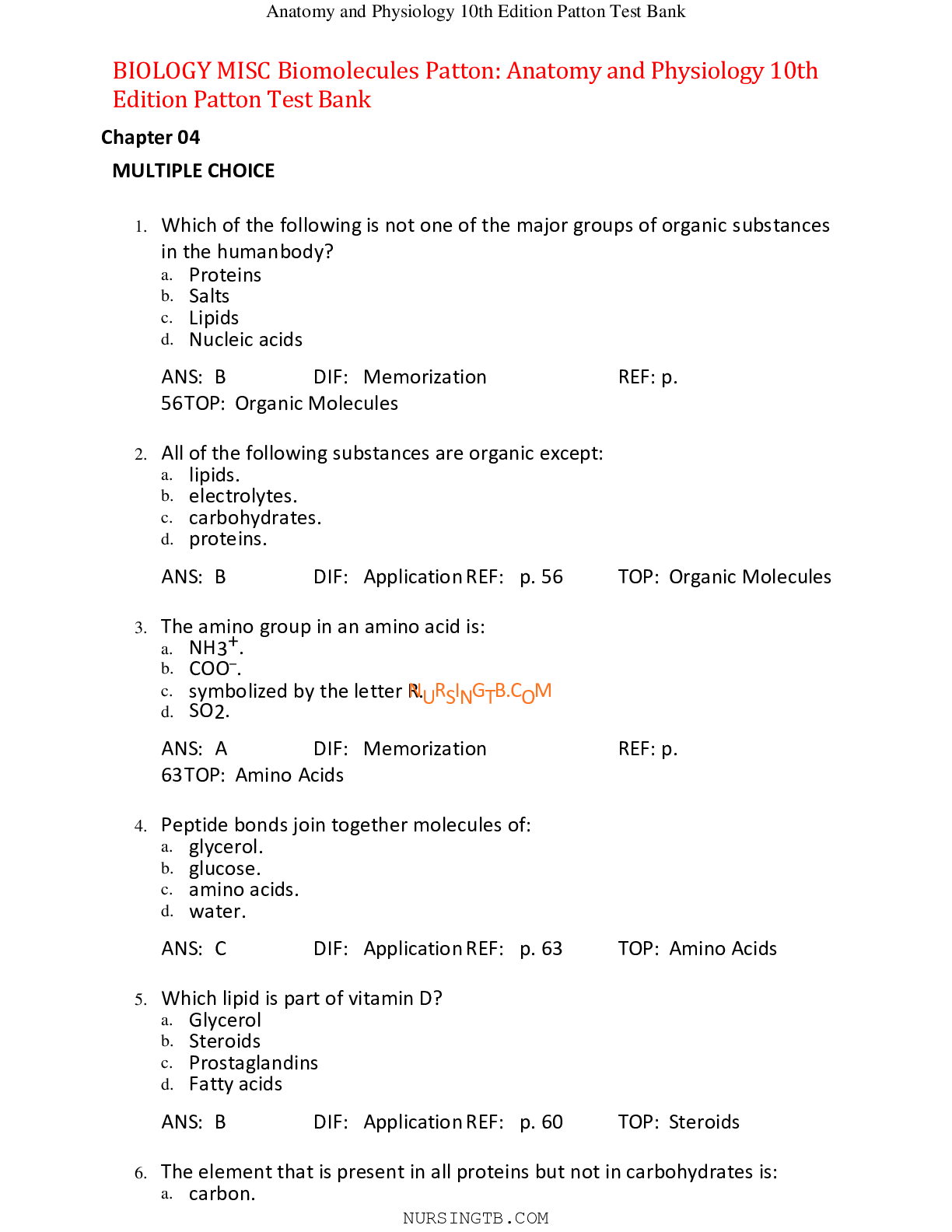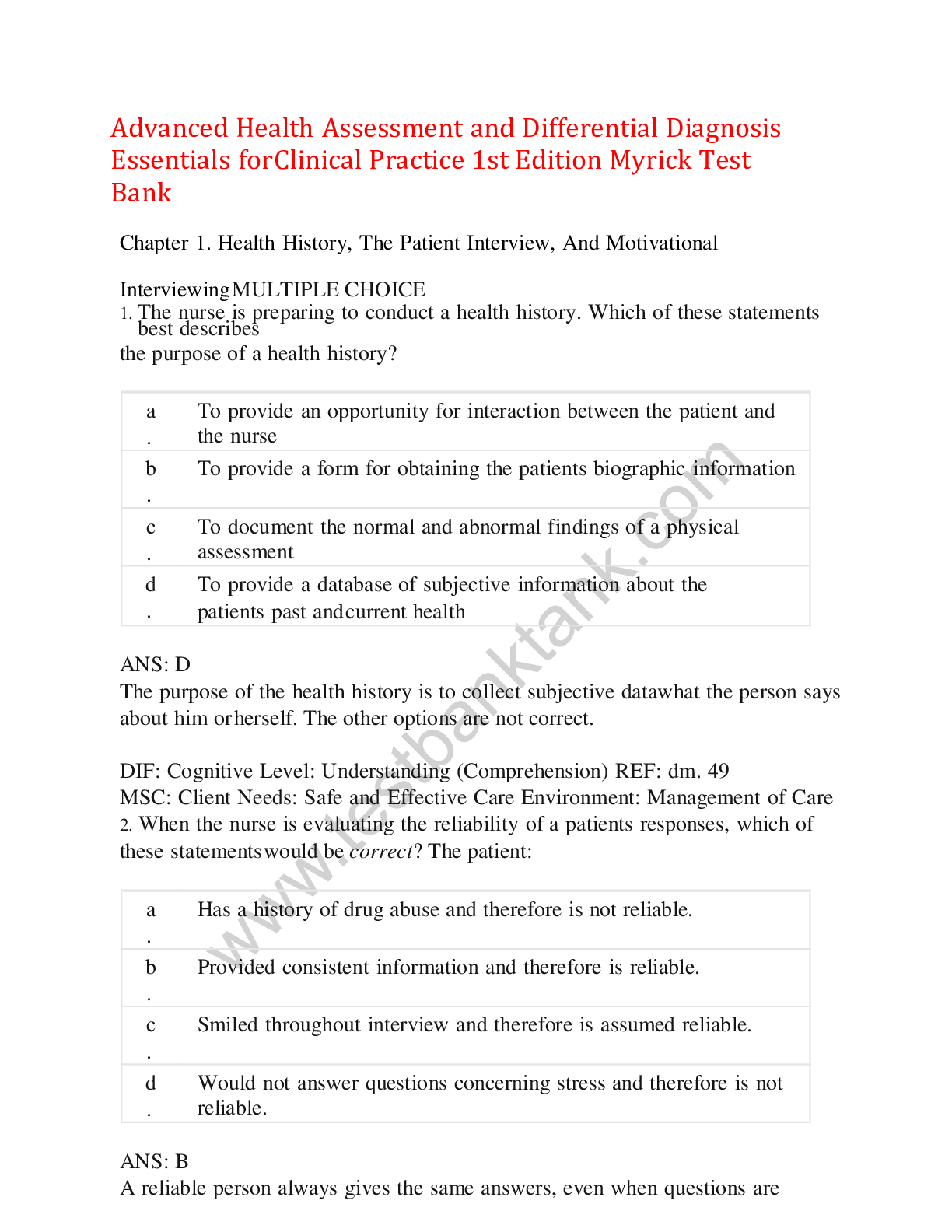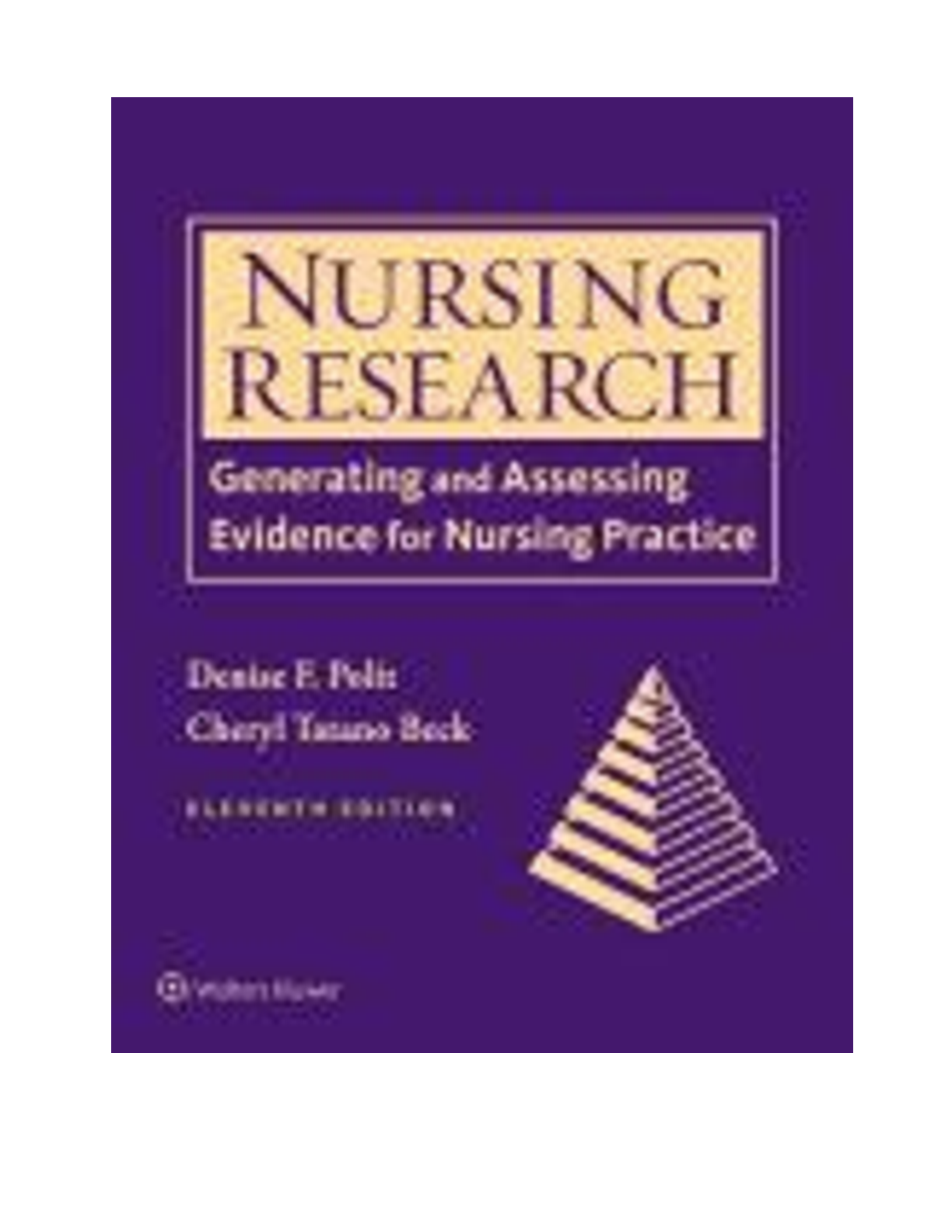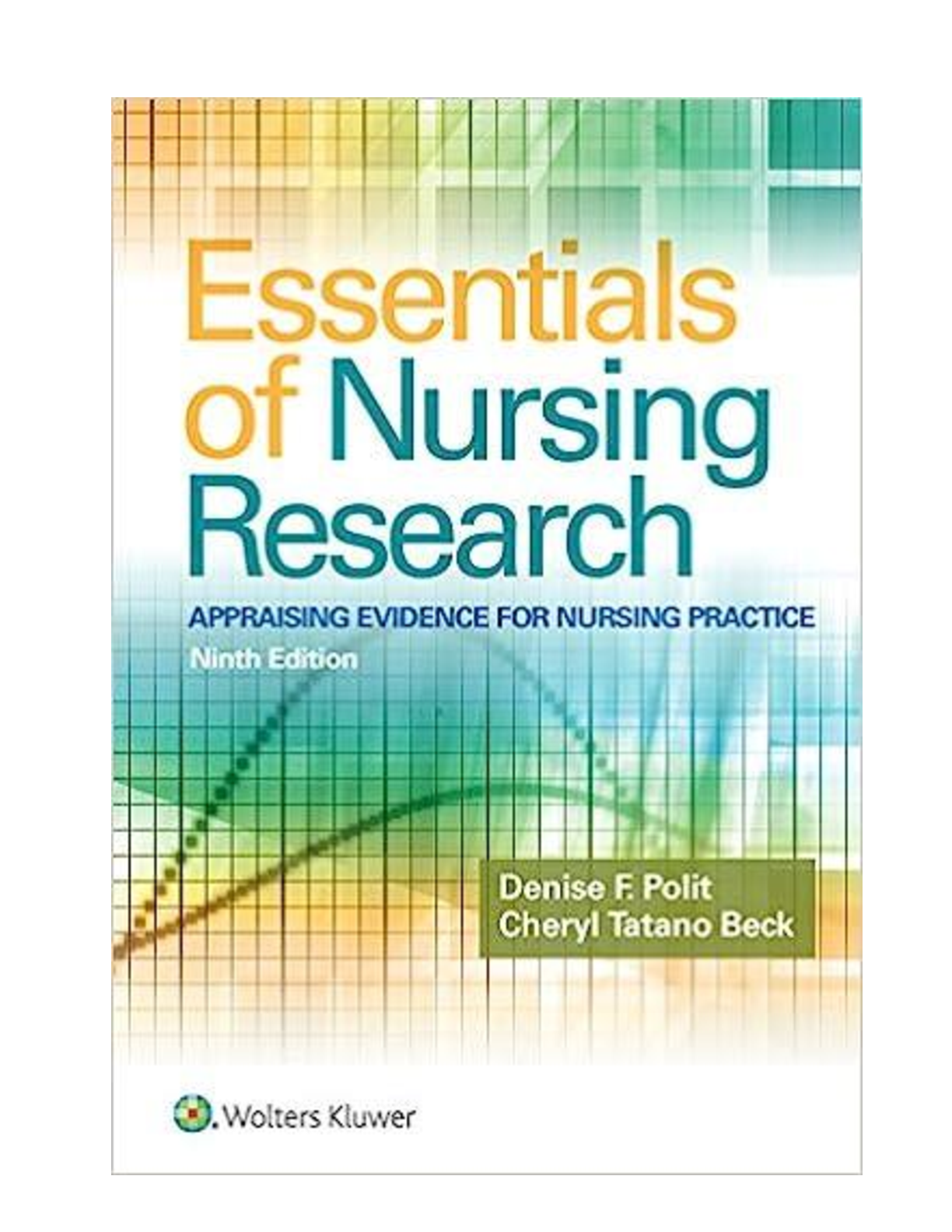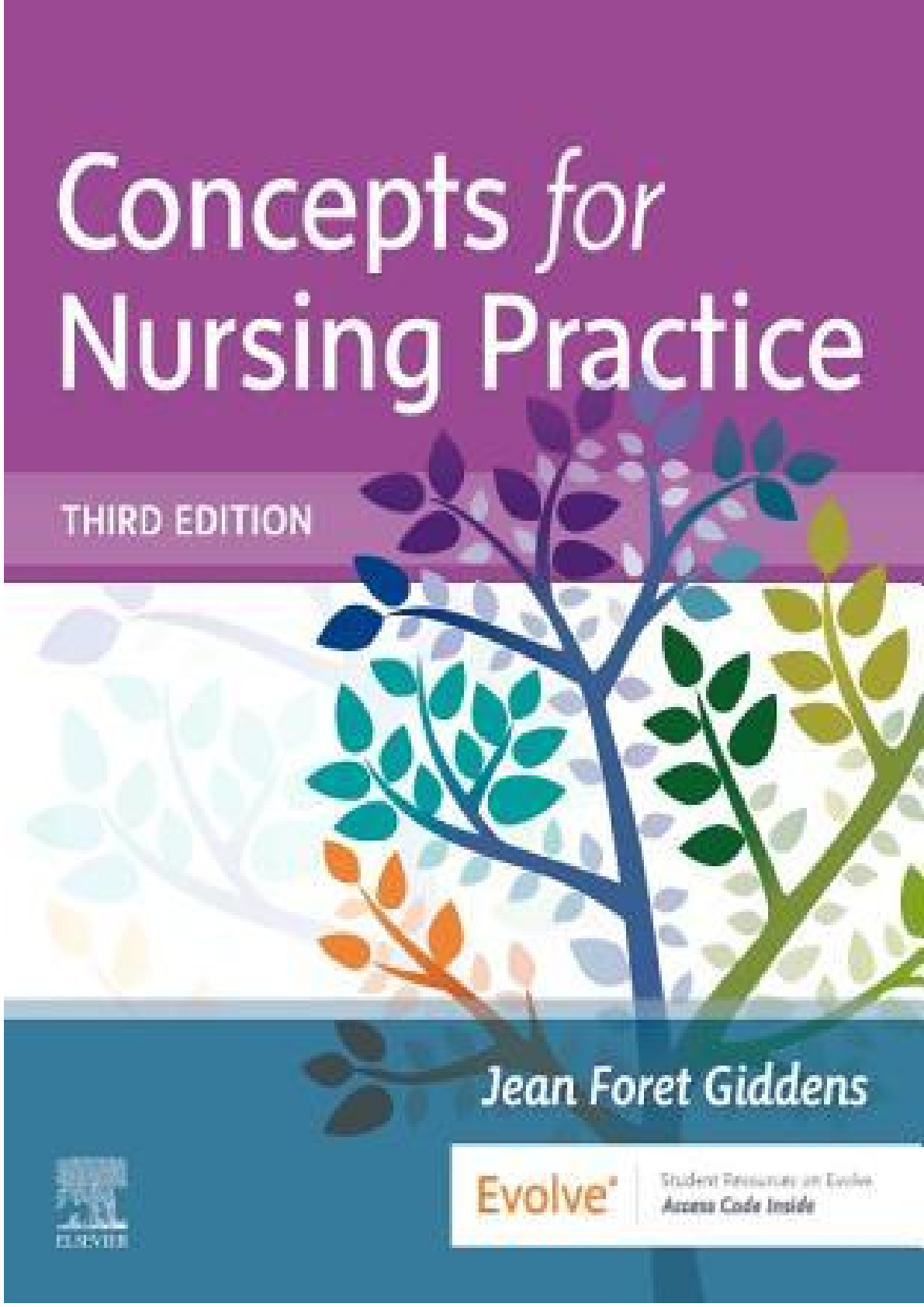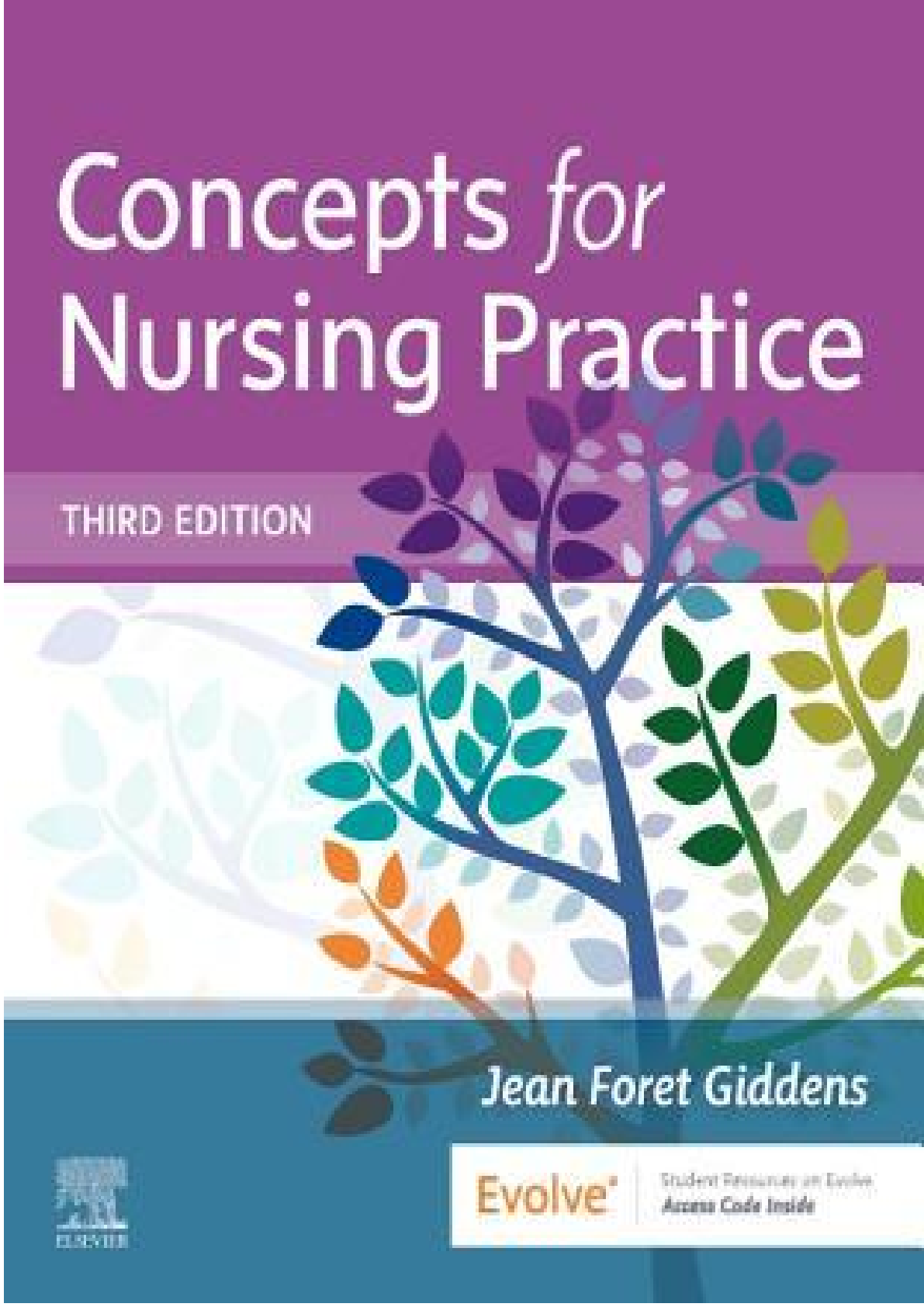*NURSING > TEST BANK > Test Bank Ethics Potter: Essentials for Nursing Practice, 8th Edition,100% CORRECT (All)
Test Bank Ethics Potter: Essentials for Nursing Practice, 8th Edition,100% CORRECT
Document Content and Description Below
Test Bank Ethics Potter: Essentials for Nursing Practice, 8th Edition MULTIPLE CHOICE 1. A 73-year-old patient with hypertension is awaiting a triple cardiac bypass surgery. The pa- tient is h... ard of hearing and did not understand what the surgeon said regarding the surgery. The daughter is concerned that the patient does not understand the risks of the surgery. If not clarified, this would be a violation of what principle? a. Autonomy b. Justice c. Fidelity d. Nonmaleficence ANS: A Autonomy refers to a person’s independence. As a principle in bioethics, autonomy repre- sents an agreement to respect a patient’s right to determine a course of action. Justice refers to the principle of fairness: fair treatment and fair distribution of health care resources. Fi- delity refers to the agreement to keep promises and is based on the virtue of caring. Non- maleficence is actively seeking to do no harm. PTS: 1 DIF: Cognitive Level: Analyzing (Analysis) REF: 77 OBJ: Describe and defend patient advocacy and the nurse’s role. TOP: Nursing Process: Evaluation MSC: NCLEX: Management of Care 2. A 45-year-old mother of two children has cirrhosis of the liver and is on a waiting list for a liver transplant. She had to meet certain criteria to be eligible to receive a liver. She under- stands that she is next on the list for a donor liver that matches. This is an example of which ethical principle? a. Autonomy b. Justice c. Fidelity d. Nonmaleficence ANS: B Justice refers to the principle of fairness. In health care, the term is used to reflect a commit- ment to fair treatment and fair distribution of health care resources. You may find reference to this principle during discussion about issues of access to care. It is not always clear just how to achieve a fair distribution of resources. Autonomy refers to independence and self- determination. Fidelity refers to the agreement to keep promises and is based on the virtue of caring. Nonmaleficence refers to the fundamental agreement to do no harm. PTS: 1 DIF: Cognitive Level: Analyzing (Analysis) REF: 78 OBJ: Describe and defend patient advocacy and the nurse’s role. TOP: Nursing Process: Evaluation MSC: NCLEX: Management of Care 3. A registered nurse who works on an oncology unit discussed pain control options that the primary health care provider had ordered with a patient undergoing treatment for pancreatic cancer. The patient requested that the intravenous (IV) pain medication be given on a regular basis. The nurse agreed to provide the IV pain medication as requested and continued to reevaluate the pain levels. The nurse is following which ethical principle? a. Autonomy b. Justice c. Fidelity d. Nonmaleficence ANS: C Fidelity refers to the agreement to keep promises. The principle of fidelity also promotes the obligation of a nurse to follow through with the care offered to patients. Autonomy refers to independence and self-determination, which is what the patient followed, but the question asked for which principle the nurse followed. Justice refers to fairness or equity of health care resources. Nonmaleficence refers to the fundamental agreement to do no harm. PTS: 1 DIF: Cognitive Level: Analyzing (Analysis) REF: 78 OBJ: Describe and defend patient advocacy and the nurse’s role. TOP: Nursing Process: Evaluation MSC: NCLEX: Management of Care 4. A registered nurse knows that an oncology patient undergoing a bone marrow transplant will spend weeks in isolation in the hospital. During that time the patient will be at an increased risk for infection and other complications and may not recover. The nurse ensures that the patient has been given information regarding the risks and potential benefits of the proce- dure. The nurse is following which ethical principle? a. Autonomy b. Justice c. Fidelity d. Nonmaleficence ANS: D The principle of nonmaleficence (do no harm) promotes a continuing effort to consider the potential for harm even when it is necessary to promote health. It is helpful in guiding your discussions about new or controversial technologies. Autonomy deals with independence and self-determination. Justice refers to fairness or equity of health care resources. Fidelity refers to maintaining promises and faithfulness. PTS: 1 DIF: Cognitive Level: Analyzing (Analysis) REF: 78 OBJ: Describe and defend patient advocacy and the nurse’s role. TOP: Nursing Process: Evaluation MSC: NCLEX: Management of Care 5. A registered nurse is working on a pediatric oncology unit and caring for four children un- dergoing chemotherapy. Today a new nursing assistive personnel (NAP) who has passed a competency examination is assigned to the team. The nurse will delegate a portion of the fundamental nursing tasks to the NAP during the shift, but realizes that he or she is still re- sponsible for his or her own actions and is accountable for the care. The nurse is following which principle of behavior? a. Ethical dilemma b. Code of ethics c. Bioethics d. Feminist ethics ANS: B The code of ethics reflects underlying principles that include responsibility, accountability, respect for confidentiality, competency, judgment, and advocacy. An ethical dilemma exists when the right thing to do is not clear or when members of the health care team cannot agree on the right thing to do. The study of bioethics represents a particular branch of ethics (i.e., the study of ethics within the field of health care). Feminist ethics proposes that we routinely ask how ethical decisions will affect women as a way to repair a history of inequality (Lin- deman, 2005). PTS: 1 DIF: Cognitive Level: Analyzing (Analysis) REF: 78 OBJ: Describe and defend patient advocacy and the nurse’s role. TOP: Nursing Process: Evaluation MSC: NCLEX: Management of Care 6. The mother of a 45-year-old patient is a retired physician and requests to discuss the pa- tient’s plan of care with the nurse caring for the patient. What is the nurse’s best response to this request? a. “I will need to ask permission from my supervisor before I can share that informa- tion.” b. “I will show you the chart, just follow me and we can discuss your questions and concerns.” c. “I would suggest that you leave me out of your family problems. I am here to care for the patient.” d. “I will have to get the patient’s permission before I can share that information.” ANS: D Even family members or friends of the patient are not permitted access to the patient’s per- sonal health information without the patient’s consent. Federal legislation known as HIPAA (Health Insurance Portability and Accountability Act of 1996) requires that those with ac- cess to personal health information not disclose the information to a third party without pa- tient consent. The nurse does not need to ask permission from the supervisor because HIPAA laws state what the nurse can do. “I would suggest that you leave me out of your family problems” is inappropriate because it ignores the request of the family member. Showing the chart and discussing the care is a violation of HIPAA. PTS: 1 DIF: Cognitive Level: Applying (Application) REF: 80 OBJ: Describe and defend patient advocacy and the nurse’s role. TOP: Nursing Process: Implementation MSC: NCLEX: Management of Care 7. A nurse bases ethical decisions on the effect, or consequences, an act will have and uses the following guidelines: the greatest good for the greatest number of people. Which ethical sys- tem is the nurse using? a. Legal b. Deontology c. Utilitarianism d. Ethics of care ANS: C Utilitarianism guides us to measure the effect, or consequences, that an act will have. The greatest good for the greatest number of people is the guiding principle for action in this sys- tem. By comparison, deontology focuses less on consequences and looks to the presence of pure principles of autonomy, justice, fidelity, beneficence, and nonmaleficence. Ethical is- sues differ from legal issues. Legal issues are resolved by reference to laws that tend to be concrete and publicly determined. Ethics of care suggest that health care workers resolve ethical dilemmas by paying attention to relationships and stories of the participants and by promoting a fundamental act of caring. PTS: 1 DIF: Cognitive Level: Applying (Application) REF: 81 OBJ: Discuss the foundations of ethics and ethical practice in nursing. TOP: Nursing Process: Evaluation MSC: NCLEX: Management of Care 8. A registered nurse has recently been reassigned to the gynecology unit at the hospital. The nurse is strongly against abortion because of religious beliefs and contacts the nursing su- pervisor regarding the assignment because the unit cares for women who are undergoing abortions. The nurse is having a conflict in which area? a. Confidentiality b. Values c. Social networking d. Culture ANS: B The nurse is having a conflict in values because of religious beliefs and abortion. A value is a personal belief about the worth of an idea, a custom, or an object. Confidentiality is not the issue because no confidences have been broken. Social networking is online communica- tion, which is not the issue in this scenario, values are the issue. The nurse is not having a conflict in culture, but in beliefs and values. PTS: 1 DIF: Cognitive Level: Applying (Application) REF: 77 OBJ: Describe the process for recognizing and resolving an ethical dilemma. TOP: Nursing Process: Assessment MSC: NCLEX: Management of Care 9. A 9-year-old patient was severely burned and has been undergoing whirlpool treatments to debride the wounds. The patient is crying and does not want to go to the physical therapy department for treatment. The registered nurse caring for the patient knows that, even though it is uncomfortable, the patient needs to have the therapy for the wounds to heal properly. The nurse is demonstrating which ethical principle? a. Autonomy b. Bioethics c. Justice d. Beneficence ANS: D The principle of beneficence promotes taking positive, active steps to help others. It encour- ages a nurse to do good for the patient. Beneficence guides decisions in which the benefits of a treatment pose a risk to the patient’s well-being or dignity. Autonomy refers to indepen- dence and self-determination. The study of bioethics represents a particular branch of ethics (i.e., the study of ethics within the field of health care). Justice refers to the principle of fair- ness. In health care the term is used to reflect a commitment to fair treatment and fair distri- bution of health care resources. PTS: 1 DIF: Cognitive Level: Analyzing (Analysis) REF: 78 OBJ: Describe and defend patient advocacy and the nurse’s role. TOP: Nursing Process: Evaluation MSC: NCLEX: Management of Care 10. Although a registered nurse has been working for several years as a staff nurse on an adult oncology unit, the nurse recently transferred to a pediatric unit in the hospital. The nurse will be in orientation for several days to learn about the different systems and will need to demonstrate proficiency in various pediatric areas such as medication administration. Which behavior is the nurse demonstrating? a. Competency b. Judgment c. Advocacy d. Utilitarianism ANS: A In the practice of nursing, competence ensures the provision of safe nursing care (profi- ciency in pediatric medication administration). The agreement to practice with competence is a common denominator for all state regulations and is in the nursing code of ethics. Judg- ment refers to the ability to form an opinion or draw sound conclusions. Advocacy involves speaking up for patient care issues from your unique perspective and advocating for humane and dignified care. You use a utilitarian ethic when determining the value of something based primarily on its usefulness and effects or consequences. The greatest good for the greatest number of people is the guiding principle for action in this system (utilitarian). PTS: 1 DIF: Cognitive Level: Analyzing (Analysis) REF: 79 OBJ: Discuss the foundations of ethics and ethical practice in nursing. TOP: Nursing Process: Evaluation MSC: NCLEX: Management of Care 11. Which behavior best indicates that the nurse is fulfilling ethical responsibilities? a. Delivers competent care b. Applies the scientific process c. Forms interpersonal relationships d. Evaluates new computerized technologies ANS: A Delivers competent care is the best example because the American Nurses Association (ANA) and the International Council of Nurses (ICN) publish codes of ethics for nurses that set principles of behavior for nurses to embrace. They reflect common underlying principles that shape professional nursing practice, including responsibility, accountability, respect for confidentiality, competency, judgment, and advocacy. The scientific process, interpersonal relationships, and new technologies do not indicate ethical behavior like competent care. PTS: 1 DIF: Cognitive Level: Analyzing (Analysis) REF: 78 OBJ: Discuss the foundations of ethics and ethical practice in nursing. TOP: Nursing Process: Evaluation MSC: NCLEX: Management of Care 12. A nurse decides to withhold a medication because it will further lower a patient’s respiratory rate. In this case, the nurse is practicing what principle? a. Responsibility b. Privacy c. Ethics d. Moral behavior ANS: A Responsibility refers to the execution of duties associated with a nurse’s role. For example, when administering a medication, you are responsible for assessing the patient’s need for the medication, giving it safely and correctly, and evaluating the patient’s response to it. Moral behavior refers to judgment about right and wrong behavior. Ethics refers to the considera- tion of standards of conduct, particularly the study of right and wrong behavior. A funda- mental right of patients is the right to privacy. Privacy becomes a focus of increasing interest as health care becomes digitized, but it is not a focus of this scenario. PTS: 1 DIF: Cognitive Level: Applying (Application) REF: 78 OBJ: Discuss the foundations of ethics and ethical practice in nursing. TOP: Nursing Process: Evaluation MSC: NCLEX: Management of Care 13. A patient is about to undergo a new, controversial bone marrow transplant procedure. The procedure may cause periods of pain and suffering. Although nurses agree to do no harm, this procedure may be necessary to promote health. This is an example of which ethnical principle? a. Autonomy b. Justice c. Fidelity d. Nonmaleficence ANS: D Nonmaleficence refers to the fundamental agreement to do no harm. The principle of non- maleficence promotes a continuing effort to consider the potential for harm even when it is necessary to promote health. Autonomy refers to a person’s independence. Justice refers to the principles of fairness. Fidelity refers to the agreement to keep promises. PTS: 1 DIF: Cognitive Level: Applying (Application) REF: 78 OBJ: Describe and defend patient advocacy and the nurse’s role. TOP: Nursing Process: Evaluation MSC: NCLEX: Management of Care 14. A community health nurse states, “I wish we had just a portion of the dollars spent repairing atherosclerotic hearts to teach the community about cardiovascular risk factors.” The nurse’s statement stems from what philosophy? a. Deontology b. Feminist ethic c. Utilitarianism d. Ethics of care ANS: C Utilitarianism determines the value of something based primarily on its usefulness. Deontol- ogy defines actions as right or wrong according to principles. The feminist ethic asks how ethical decisions will affect women. The ethics of care suggests that health care workers solve ethical dilemmas by the promotion of the fundamental act of caring. PTS: 1 DIF: Cognitive Level: Applying (Application) REF: 81 OBJ: Discuss the foundations of ethics and ethical practice in nursing. TOP: Nursing Process: Assessment MSC: NCLEX: Management of Care 15. A nurse is teaching the staff about the International Council of Nurses Code of Ethics. Which major element of the Code should the nurse include in the teaching session? a. People b. Pride c. Power d. Problems ANS: A The major elements of the Code include: Nurses and People; Nurses and Practice; Nurses and the Profession; and Nurses and Co-workers. It does not include pride, power, and prob- lems. PTS: 1 DIF: Cognitive Level: Applying (Application) REF: 80 OBJ: Discuss the foundations of ethics and ethical practice in nursing. TOP: Nursing Process: Implementation MSC: NCLEX: Management of Care 16. The code of ethics for nursing sets forth ideals of nursing conduct and was developed by what organization? a. The Board of Nursing b. The American Medical Association c. The National League for Nursing d. The American Nurses Association ANS: D The American Nurses Association (ANA) and the International Council of Nurses (ICN) publish codes of ethics for nurses that set principles of behavior for them to embrace. The Board of Nursing regulates nursing programs and nursing practice. The American Medical Association deals with physicians. The National League for Nursing is an agency concerned with nursing education. PTS: 1 DIF: Cognitive Level: Remembering (Knowledge) REF: 78 OBJ: Discuss the foundations of ethics and ethical practice in nursing. TOP: Nursing Process: Evaluation MSC: NCLEX: Management of Care 17. A nurse is processing an ethical dilemma by focusing on relationships and stories of the par- ticipants. Which ethical system is the nurse using? a. Deontology b. Utilitarianism c. Feminist ethics d. Ethics of care ANS: D Ethics of care suggest that health care workers resolve ethical dilemmas by paying attention to relationships and stories of the participants and by promoting a fundamental act of caring. Attention to relationships distinguishes the ethics of care from other ethical viewpoints be- cause it does not necessarily apply universal principles that are intellectual or analytical. De- ontology defines actions as right or wrong based on “right-making characteristics” such as truth and justice. You use utilitarian ethics when determining the value of something based primarily on its usefulness and effects or consequences. Feminist ethics proposes that we routinely ask how ethical decisions will affect women as a way to repair a history of in- equality. PTS: 1 DIF: Cognitive Level: Applying (Application) REF: 81 OBJ: Discuss the foundations of ethics and ethical practice in nursing. TOP: Nursing Process: Evaluation MSC: NCLEX: Management of Care 18. A nurse is teaching the staff about how to process an ethical dilemma. Which order should the nurse use to present the steps? a. Evaluate the action. b. Negotiate the outcome. c. State the problem clearly. d. Gather all relevant information. e. Examine own values and opinions. f. Consider possible courses of action. a. d, e, c, f, a, b b. d, e, c, f, b, a c. d, c, e, f, a, b d. d, e, c, b, f, a ANS: B The steps to process an ethical dilemma include the following: (1) Is this an ethical dilemma? (2) Gather all information relevant to the case. (3) Examine and determine your own values and opinions about the issues. (4) State the problem clearly. (5) Consider possi- ble courses of action. (6) Negotiate the outcome. (7) Evaluate the action. PTS: 1 DIF: Cognitive Level: Analyzing (Analysis) REF: 82 OBJ: Describe the process for recognizing and resolving an ethical dilemma. TOP: Nursing Process: Implementation MSC: NCLEX: Management of Care MULTIPLE RESPONSE 1. A nurse is working with the parents of a seriously ill newborn. Surgery has been proposed for the infant, but the chances of success are unclear. To help the parents resolve this con- flict, which steps should the nurse take to process the ethical dilemma? (Select all that ap- ply.) a. Identifying people who can solve this dilemma b. Gathering all relevant information surrounding this dilemma c. Clarifying own values and opinions about the issues d. Consulting a professional ethicist regarding how to proceed with this dilemma e. Considering possible courses of action ANS: B, C, E The nurse should gather all relevant information, clarify own values and opinions about the issue, and consider possible courses of action. Seven steps are used when solving an ethical dilemma: (1) Asking “is it an ethical dilemma?”, (2) gathering all information, (3) examin- ing and determining one’s own values and opinions about the issue, (4) stating the problem clearly, (5) considering possible courses of action, (6) negotiating an outcome, and (7) eval- uating the action. Identifying people who can solve this dilemma and consulting a profes- sional ethicist are not steps of the process. PTS: 1 DIF: Cognitive Level: Analyzing (Analysis) REF: 82 OBJ: Describe the process for recognizing and resolving an ethical dilemma. TOP: Nursing Process: Implementation MSC: NCLEX: Management of Care [Show More]
Last updated: 1 year ago
Preview 1 out of 17 pages

Reviews( 0 )
Document information
Connected school, study & course
About the document
Uploaded On
Nov 09, 2022
Number of pages
17
Written in
Additional information
This document has been written for:
Uploaded
Nov 09, 2022
Downloads
0
Views
86

